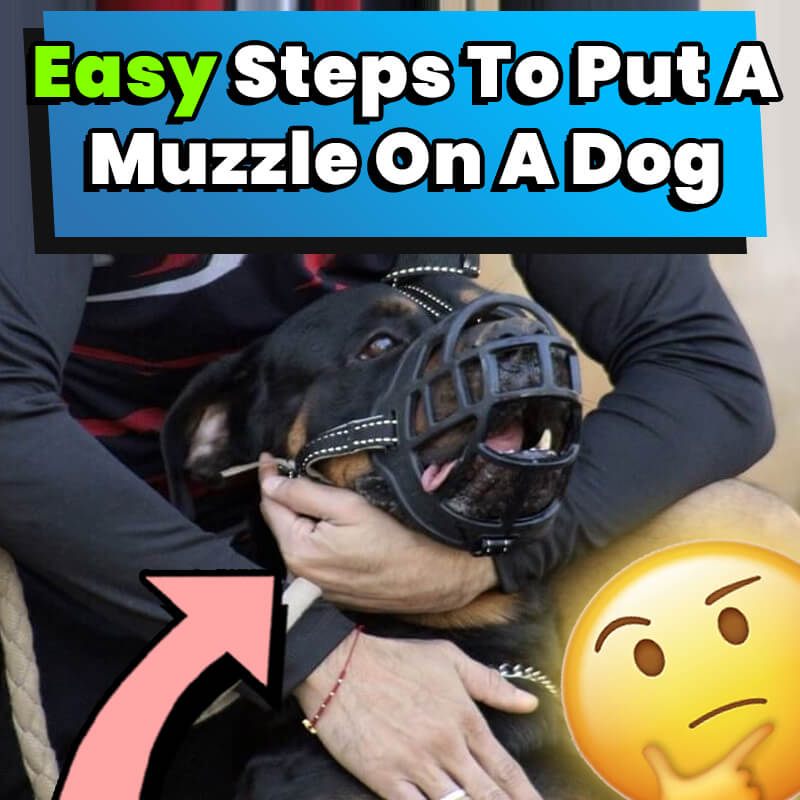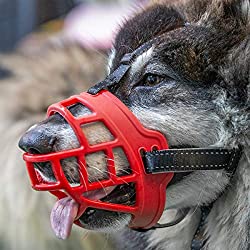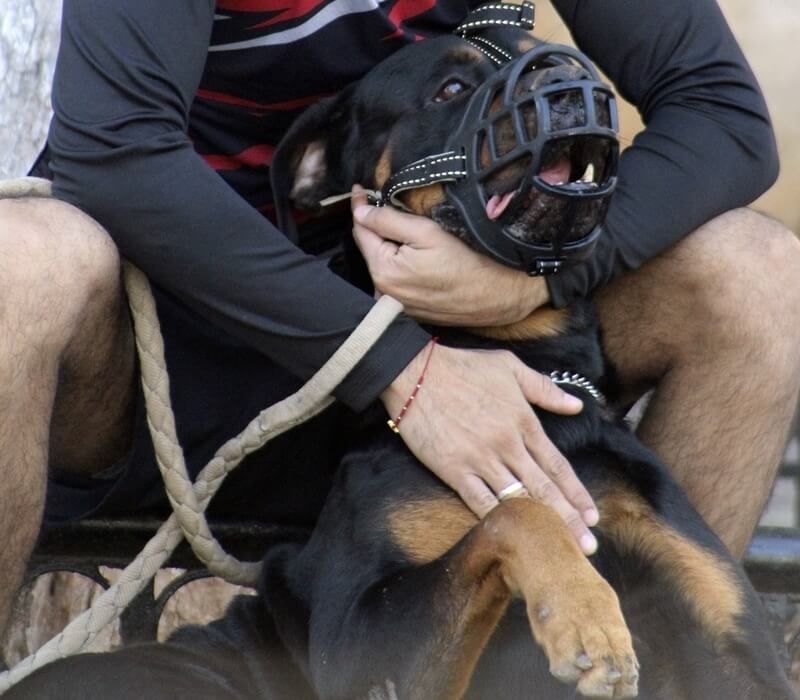
How to put a Muzzle on a dog? You’ll want to choose the right-sized Muzzle that allows your dog to pant, drink, and receive treats. Before putting on the Muzzle, get your pup familiarized with the Muzzle. Next, using treats, guide his nose into it and gradually fasten it. Always supervise them and remember, it’s only a short-term behavioral solution.
When you put a Muzzle on your dog, it should only be used as a safety measure. Specific situations may require wearing a dog Muzzle for short periods of time only.
Keep reading as we go over the step-by-step process to effectively place a Muzzle on your dog for their safety and comfort. We’ll also discuss how to put a Muzzle on both aggressive dogs and small dogs, focusing on techniques and precautions suitable for each case. Keep in mind that introducing the Muzzle should be fun. Also, have tons of treats ready!
Table of Contents
How To Put A Dog Muzzle On?
Below are four main steps to introduce your dog to the dog muzzle. Keep in mind that it takes time and patience to properly put on a dog Muzzle.
Do not rush through it or force the Muzzle on your dog. Go at a slow and steady pace.
If your furry family member gets nervous during any of these steps, stop the training for the day. When you start the training again, pick up from an earlier step. Remember to make it a great experience so there’s no negative association with a Muzzle.
DID YOU KNOW… There are several types of Dog Muzzles on the market today. Visit 4 Types Of Dog Muzzles to find out what they are.
Before we go over the four steps, let’s briefly discuss what a Dog Muzzle is and its purpose:
What is a Dog Muzzle?
A dog Muzzle is a device that is typically placed over a dog’s snout to prevent biting, barking, or eating things he shouldn’t.
Muzzles are made from various materials like leather, metal, or plastic and come in different styles to suit multiple breeds and sizes of dogs.
Despite its appearance, a well-fitted Muzzle isn’t a cruel device. It allows a dog to drink, pant, and even receive small treats.
It’s a temporary tool used in certain situations, like during grooming, vet visits, or even when introducing a dog to a new, potentially stressful environment.
Remember, a Muzzle is not a solution for behavioral issues. Professional training or veterinary advice should be sought if a dog continues to show signs of aggression. Always prioritize your dog’s comfort and safety when using a Muzzle.
RECOMMENDED: If you’re looking for the best Dog Muzzles for your furry friends, check out our Best Dog Muzzle review guide where we share with you our top picks and recommendations.
How to Muzzle a Dog: 4 Simple Steps!
Total Time Needed: 30Minutes
Total Cost: 10 USD – 100 USD
Required Tools: An appropriate Dog Muzzle for your pup, patience, consistency
Things Needed: Treats. Preferably small treats so dogs don’t get distracted during training or peanut butter
Step 1 – Show the Dog Muzzle
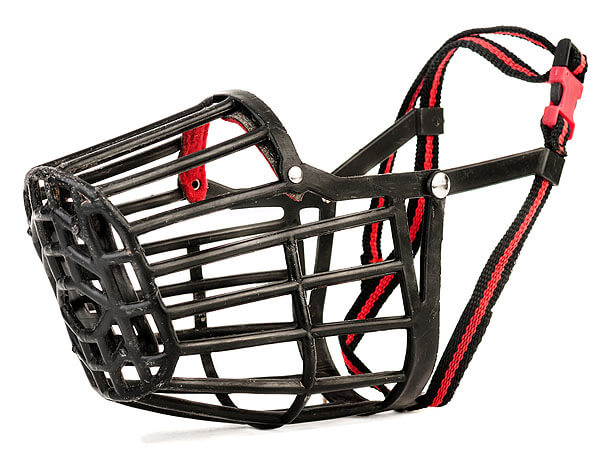
Have your furry friend sit in front of you. Kneel down and hide the Muzzle behind your back. After a few seconds, show him the Muzzle. When your puppy sees it, praise him with “yes!” and give him a treat.
Hide the Muzzle behind you again. Repeat this exercise a few times for the next 3 to 4 days.
Step 2 – Explore the Dog Muzzle
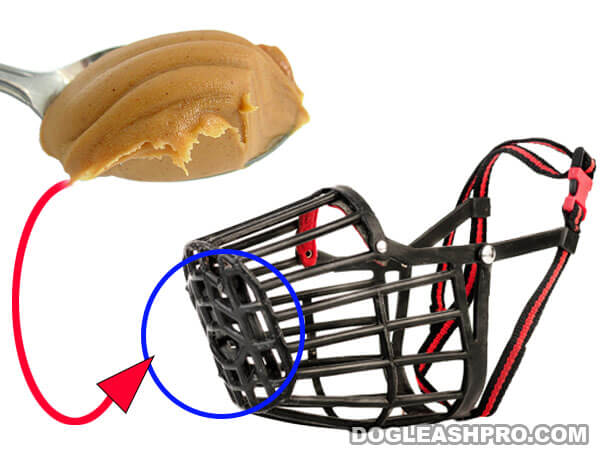
Carefully smear a bit of peanut butter inside the dog muzzle. Allow your dog to voluntarily walk up to the muzzle and sniff it. With his snout inside the muzzle, let him lick the treat for 10 seconds.
Then, gently remove the muzzle from your pup’s snout. Count 5 seconds and have him voluntarily put his snout back into the muzzle. This time, encourage your dog to keep his snout in there for about 30 seconds. Remove the muzzle again.
Repeat this step a few times. Each time, encourage him to keep the muzzle on longer than before.
A properly fitted Muzzle is crucial. Measured your dog’s snout before getting a Muzzle so it stays securely and comfortably on during muzzle training.
Step 3 – Introduce Release Buckles and Safety Straps
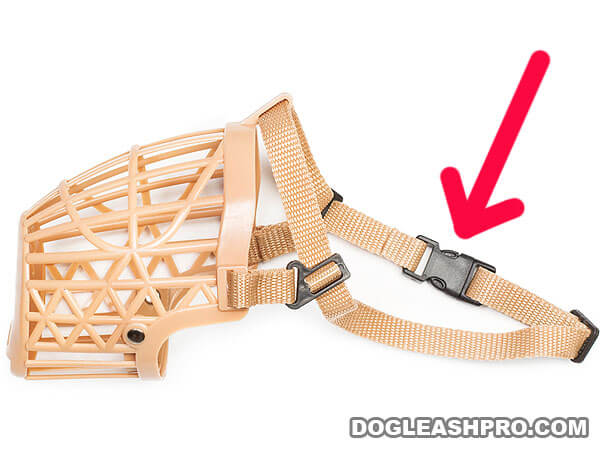
Next, introduce the muzzle’s safety straps and release buckles. Show him the safety straps and release the buckles. Give him a treat. Then, close the buckle and give him a treat.
Step 4 – Fasten and Release the Buckles
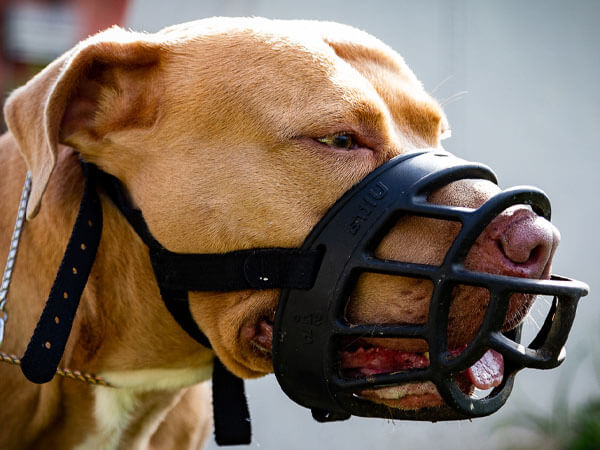
Now it’s time to fasten the muzzle onto your pup’s snout. Again, let him voluntarily stick his snout inside the muzzle. Praise him with “good boy!” when you fasten the buckles. Immediately after, release the buckles and give him a treat.
Repeat this step a few times. Every time you fasten the buckle, leave it closed a little longer than the last.
DON’T MISS: How Does A Dog Muzzle Work?
Detail information on How To Put A Muzzle On A Dog
Introducing the Dog Muzzle to your furry friend is just as important as wearing it. Make the training fun so he builds a positive association with the muzzle.
Remember that sniffing is a way for dogs to explore the Muzzle. By using peanut butter, it should attract your dog to put his snout inside the Muzzle so he can lick it.
Do not push or shove the Muzzle onto your pup’s snout. Doing so may stress him out or get him very anxious. Allow him to voluntarily put his snout into the Muzzle during these steps.
Keep in mind that dogs are sensitive to noise. It’s imperative that your furry friend becomes comfortable with the sound of the buckles when you fasten and release it.
After repeating step 3 several times, your dog should start to feel comfortable with the sound of the buckles and associate it with treats.
Check that the safety straps are adjustable. The muzzle should fit comfortably and securely on your dog’s snout. It should neither be too tight nor too loose.
Never leave a Muzzled dog unattended
Remember that using a Dog Muzzle is meant to be a short-term temporary safety measure. Monitor your furry family member and never leave a Muzzled dog unattended or unsupervised.
Also, please do not use the Dog Muzzle as a form of punishment. It should only be used to protect your dog and those around him.
Be careful with how you use the Muzzle. If your K9 friend has a habit of biting children, have him wear the Muzzle around them. Don’t allow children to pet him either. Doing so may stress your pup out and this negates the purpose of the Muzzle.
READ ALSO: What Are Dog Muzzles Used For?
How To Put A Muzzle On A Dog: FAQ
Should I Muzzle My Dog?
Deciding to Muzzle your dog is a serious consideration, and it’s usually brought up when a dog has behavior problems like biting or aggressive chewing. However, there’s a lot to consider before you decide to go down this route.
Why Muzzle a Dog?
There are a few reasons why people might consider muzzling their dog:
- Aggressive behavior: If your pup has a history of biting people or other animals, a Muzzle can be a short-term solution while you work on behavior modification with a professional.
- Grooming or medical procedures: Some dogs become fearful or aggressive during these procedures, so a Muzzle can help ensure the safety of everyone involved.
- Eating inappropriate things: Dogs that eat dangerous things like rocks, garbage, or toxic plants might need a muzzle for their own safety during walks.
Ultimately, it all comes down to the safety and well-being of your dog and those around it. If you’re considering a Muzzle, ensure it’s done correctly, respectfully, and not as a replacement for proper training and socialization.
READ NEXT: How to Measure A Dog For A Muzzle
Are Muzzles Bad For Dogs?
Are you curious about whether Muzzles are bad for dogs? It’s an excellent question; the answer isn’t a simple ‘yes’ or ‘no.’
It all depends on how and why the Muzzle is used. Let’s break it down:
- Muzzles can be positive tools if used correctly: They can be a way to ensure safety during interactions with an anxious or fearful dog, during vet visits, grooming, or when a dog is known to eat inappropriate things. In these situations, a Muzzle can act as a safety net and potentially prevent harm.
- Muzzles are not punishment tools: If Muzzles are used as a form of punishment or to suppress behaviors without addressing the underlying cause, then they can indeed be bad for dogs. This can lead to stress, anxiety and can potentially exacerbate aggressive behavior.
- Incorrect type or improper fit is harmful: The wrong kind of Muzzle or one that doesn’t fit properly can cause physical harm to your pup. It can lead to difficulty in panting (dogs’ primary way to cool down), drinking, or even causing skin chafing. That’s why it’s crucial to use a well-fitting, basket-type Muzzle.
- Muzzles shouldn’t replace training: If your dog shows signs of aggression, the Muzzle can help keep others safe in the short term, but it’s not a solution to the problem. Working with a professional to address these behaviors is critical.
In a nutshell, Muzzles aren’t inherently bad for dogs. But like any tool, they must be used correctly and for the right reasons.
Always remember that a Muzzle is a temporary solution and not a substitute for behavioral training or tackling the root cause of a problem.
How Long Should A Dog Wear A Muzzle?
Understanding how long a dog should wear a Muzzle is essential for their safety and comfort. Here’s what you need to know:
- Short periods are best: Generally, a Muzzle should be worn for short periods of time, usually no longer than an hour. But this can depend on the situation, the type of Muzzle, and how comfortable your dog is with it.
- Breaks are crucial: If a Muzzle needs to be worn for an extended period, give your dog breaks every 20 to 30 minutes. During this break, they can pant freely and drink water.
- Consider the situation: The situation also determines how long the Muzzle is on. For example, a Muzzle might be needed only for a few minutes during a vet visit or grooming session.
- Training can extend time: If you’re training your K9 friend to get used to the Muzzle, start with very short periods (like a few seconds to a minute) and slowly increase the time as your pooch gets more comfortable.
- Monitor your dog: Always keep an eye on your pups while they’re wearing a Muzzle. If they seem distressed or are trying to remove it, it may be time to take it off and give them a break.
Are Muzzles Safe For Dogs?
Generally, Muzzles can be safe for dogs when used correctly and under the right circumstances. Let’s break it down:
- Correct type and size: Not all Muzzles are created equal. A safe Muzzle fits correctly, allowing your dog to pant, drink, and accept treats. Usually, a basket Muzzle is the best choice.
- Proper usage: Muzzles are safe when used correctly. They should never be used as a punishment or to manage barking, chewing, or other destructive behaviors. If used inappropriately, they can cause stress and anxiety.
- Supervision is a must: Never leave a Muzzled dog unattended. This is important for safety as a dog can injure itself trying to remove the Muzzle.
- Training: Muzzles should be introduced using positive reinforcement so that the dog doesn’t associate it with fear or punishment.
- Consult professionals: If you’re considering using a Muzzle because your dog is aggressive or fearful, it’s safest to consult a professional trainer or behaviorist.
So, yes, Muzzles can be safe for dogs, but they must be used correctly and responsibly.
You may be interested in: Do Muzzles Stop Dogs From Barking?
Can A Dog Eat With A Muzzle On?
It depends on the type of Muzzle you’re using.
If your dog is wearing a basket Muzzle, then yes, they can still eat while wearing it.
Basket Muzzles are designed with enough space for a dog to open his mouth, allowing him to pant, drink water, and accept treats or kibble.
That said, eating a whole meal can be tricky depending on the size of the food and the Muzzle’s design, but it’s generally possible.
On the other hand, a dog wearing a soft or sleeve Muzzle, which holds the mouth more closed, won’t be able to eat, drink, or pant effectively.
These types of Muzzles should only be used for very short periods, like during a vet visit, and under constant supervision.
So, while a dog can technically eat with a basket Muzzle on, it’s usually best to feed them their meals without the Muzzle.
Muzzles can make it harder for them to eat comfortably, and besides, meal times should be a relaxing and enjoyable experience for your furry friend.
You may also like: How Long Can A Dog Wear A Muzzle?
Can Dogs Drink With A Muzzle On?
Just like eating, whether a dog can drink with a Muzzle on depends on the type of Muzzle.
Basket Muzzles: These Muzzles are designed to allow your pup to open his mouth, which means he can pant, eat, and yes – drink water!
You K9 friend can lap up water through the spaces in the Muzzle. This way, he can stay hydrated even with the Muzzle on.
Soft or Sleeve Muzzles: These Muzzles fit more snugly around a dog’s mouth and hold it closed. Because of this, your furry friend can’t drink, eat, or pant effectively when wearing this type of Muzzle. They should only be used for short periods and under close supervision.
So, if your pup is wearing a basket Muzzle and is thirsty, he should be able to drink without a problem.
But it’s always a good idea to monitor them to ensure they’re comfortable and getting enough water.
And if they’re wearing a soft or sleeve Muzzle, it’s best to remove it if they need to drink water. Hydration is super important for our furry friends!
How To Put A Muzzle On A Dog That Bites?
Putting a Muzzle on a dog that’s known to bite can be tricky.
Here’s a step-by-step guide to help you get through the process as smoothly as possible.
Remember to take it slow and associate the Muzzle with positive experiences to make it easier for your pup.
- Choose the right Muzzle: The first step on how to Muzzle a dog that bites is choosing the proper Muzzle. You’ll want to choose a comfortable, well-fitting Basket Muzzle that allows your dog to pant, drink, and take treats.
- Introduce the Muzzle positively: Show the Muzzle to your dog and let them investigate it. Whenever they interact with the Muzzle in any way, reward them with a treat or praise. The goal here is to help them associate the Muzzle with positive experiences.
- Train your dog to put their nose in the Muzzle: Hold the Muzzle with one hand and a treat with the other. Encourage your dog to put their snout inside the Muzzle to get the treat. At this stage, you’re not trying to fasten the Muzzle yet. You’re just getting them used to putting their snout in it.
- Gradually increase wearing time: After your dog is comfortable putting their snout in the Muzzle, practice fastening it for short periods. Always reward your dog with treats and positive reinforcement, and gradually increase the amount of time they wear the muzzle.
- Practice in different environments: Once your dog is comfortable wearing the Muzzle at home, try using it in other settings where they might feel nervous or display aggressive behavior. This helps them get used to the muzzle in different situations.
Remember, dealing with a dog that bites can be challenging. Make sure to work with a professional trainer or behaviorist.
Muzzles are not a long-term solution, but they can keep everyone safe while you’re addressing the root causes of your dog’s behavior.
So, Can A Dog Bite With A Muzzle On?
It largely depends on the type of Muzzle.
Basket Muzzles: These look like a cage over the dog’s mouth. They’re designed to allow the dog to pant, drink, and take treats, but they make it really hard for a dog to bite.
So, with a properly fitted basket Muzzle, the chances of a dog being able to bite are pretty low.
Soft Muzzles: These Muzzles wrap around the dog’s mouth and hold it closed. This means the dog can’t really open their mouth to bite. But remember, because they restrict the dog’s ability to pant or drink, they should only be used for short periods.
Remember, even the best Muzzle isn’t 100% bite-proof, especially if it needs to be correctly fitted or fastened. Always use Muzzles as part of a larger training plan and under the guidance of a professional if possible. Safety first, for both you and your furry friend!
How To Put A Muzzle On An Aggressive Dog?
Muzzling an aggressive dog can be challenging, but with patience and the right approach, it can be done safely. Here’s a step-by-step guide to help you out:
- Select the right Muzzle: First, you’ll want a basket-style Muzzle. This allows the dog to breathe, pant, drink, and accept treats, making it much more comfortable for extended wear.
- Positive associations: The Muzzle shouldn’t be scary. Let your pooch sniff it, investigate it, and get used to its presence. When your dog interacts positively with the Muzzle (sniffing or touching), reward them with a treat or praise.
- Introduce the Muzzle gently: Hold the Muzzle with one hand and a delicious treat in the other. Let your dog put his snout into the Muzzle to get the treat. Avoid fastening the Muzzle at this stage. Simply let your dog get used to it first.
- Gradually increase Muzzle time: Once your dog is comfortable sticking their snout in the Muzzle, you can start securing it for short periods. Always reward your dog when the Muzzle is on and gradually increase the time they wear it.
- Practice in different situations: Use the Muzzle in various environments where your dog might display aggressive behavior. This helps them get used to wearing the Muzzle under different conditions.
Working with a professional when dealing with an aggressive dog is essential. They can guide you through this process safely and help address the underlying cause of the aggression.
Muzzles are a tool for management and safety, but they don’t replace behavior modification training.
How To Put A Muzzle On A Small Dog?
Putting a Muzzle on a small dog involves the same steps as a bigger one, but given their size, you need to be a little extra gentle. Here’s the lowdown on how you can go about it:
- Pick the right Muzzle: Size is especially important for small dogs. Make sure you get a Muzzle that’s the right size for your little buddy. A Basket Muzzle is generally a good choice because it allows for panting, drinking, and eating treats.
- Positive vibes: Let your small dog get used to the Muzzle in a non-threatening way. Allow them to sniff it, and reward them with treats or praise whenever they show interest in the Muzzle.
- Teach them to put their snout in: With a treat in one hand and the Muzzle in the other, encourage your dog to put their snout into the Muzzle to get the treat. Keep the experience positive and pressure-free. Wait to fasten the Muzzle.
- Increase Muzzle time slowly: Once they’re comfortable with their snout in the Muzzle, you can start securing it for short periods. Always follow up with rewards. Gradually increase the time your dog spends with the Muzzle on.
- Practice in different scenarios: As your small dog gets more comfortable, use the Muzzle in different environments. This helps them get used to wearing the Muzzle in various situations.
Remember, small dogs can be just as nervous, or even more so, than larger dogs when it comes to new experiences like wearing a Muzzle.
So, take it slow, be patient, and keep the experience positive. It’s always best to consult a professional if you’re having trouble or if the Muzzle is being used to address behavioral issues.
How To Put A Muzzle On A Chihuahua?
Got a Chihuahua that needs a Muzzle? They might be small, but boy, do they have spirit! Let’s talk about the best way to introduce a Muzzle to your tiny, feisty friend:
- Find a Perfect Fit: When it comes to Chihuahuas, finding a properly fitting Muzzle is crucial due to their small size. Ensure it’s comfortable and allows for panting, drinking, and taking treats.
- Slow and Steady: Start by letting your Chihuahua sniff the Muzzle and explore it on their own terms. Provide treats as a reward for any interaction with the Muzzle to create positive associations.
- Treat Luring: Next, place a yummy treat in the Muzzle and let your Chihuahua stick their snout in to get it. Don’t rush to fasten it – the goal is just to get them comfortable with the feeling of the Muzzle.
- Short Sessions: When your Chihuahua seems okay with the Muzzle, begin fastening it for very short periods. Make sure you’re offering lots of praise and treats.
- Increase Time Gradually: Slowly extend the time your Chihuahua wears the Muzzle, ensuring they’re always comfortable and rewarded for their patience.
- Muzzle Practice: As your Chihuahua gets used to wearing the Muzzle, start incorporating it into different environments and situations to help them adjust.
Remember, patience is key! It might take some time for your little one to get used to the Muzzle, but they’ll get there with positive reinforcement and a gentle approach. And, if you’re using the Muzzle due to biting or other aggressive behaviors, don’t hesitate to contact a professional for additional help and guidance.
Are Soft Muzzles Safe For Dogs?
Soft Muzzles, sometimes called sleeve Muzzles, can be used safely, but they have some important considerations.
Soft Muzzles wrap around a dog’s mouth and hold it closed. This means that a dog can’t pant, drink, or eat properly while wearing one.
Panting is the primary way dogs cool themselves down, so if they can’t pant, they can’t regulate their body temperature. Because of this, soft Muzzles should only be used for very short periods and under constant supervision.
You also want to be sure that the Muzzle isn’t causing your furry friend any distress. It should be a safe and comfortable fit, not too tight but secure enough so your pup can’t easily remove it.
And remember, no matter what kind of Muzzle you’re using, it’s always a good idea to make the experience as positive as possible for your K9 friend. Use treats and praise to create positive associations, and take things slow.
If you need clarification about the best kind of Muzzle for your dog or how to use it, feel free to ask a vet or a professional dog trainer. They can give personalized advice based on your dog’s breed, size, and temperament.
How To Put A Soft Muzzle On A Dog?
If you’re planning to use a soft Muzzle on your dog, here’s how you can do that with care and ease:
- Create Positive Associations: Allow your pup to sniff the Muzzle and reward them with treats or praise for positive interactions.
- Treat Inside the Muzzle: Hold the Muzzle with one hand and a treat in the other. Let your dog place their snout inside the Muzzle to reach the treat. Don’t rush to secure the Muzzle just yet, let them get comfortable with this step first.
- Short Sessions: Once your dog is okay with placing their snout in the Muzzle, begin fastening it for very brief periods. Be sure to reward them during this step!
- Increase Time Gradually: Slowly extend the time your dog wears the Muzzle, ensuring they are always comfortable. Make sure to offer treats and praise for their cooperation.
- Monitoring: Soft Muzzles restrict a dog’s ability to pant and drink, so they should never be worn for long periods or during exercise. Always closely monitor your dog while they’re wearing a soft Muzzle.
Remember, patience and positivity are your best friends in this process. It can take time for a dog to adjust to wearing a Muzzle, so don’t rush them. And as always, if you’re uncertain or worried about anything, consult a vet or a professional dog trainer for advice.
How To Put On A Dog Muzzle Lead?
You’re using a dog Muzzle lead, sometimes known as a head halter or head collar! These are a bit different from regular Muzzles, but they can be really handy for controlling your dog’s movements, especially if they’re a bit of a puller.
Here’s how you can put it on:
- Introduction Phase: Before putting the Muzzle lead on your dog, allow them to sniff and get familiar with it. Offer treats as a reward for positive interactions.
- Treat Luring: Hold a treat through the loop of the Muzzle lead. Allow your dog to put his nose through it to get the treat. Do not fasten the Muzzle lead just yet.
- Comfort Check: Make sure your dog is comfortable with the feel of the Muzzle lead on their snout. Give them time to adjust without any pressure.
- Fasten It Up: Once your dog seems comfortable with the Muzzle lead, gently fasten it. Make sure it’s not too tight – you should be able to fit one or two fingers under the straps.
- Short Walks: Start with short walks to let your dog get used to the feel of the Muzzle lead while moving around. Reward good behavior with treats and praise.
- Gradual Increase: As your dog gets comfortable with the Muzzle lead, gradually increase the time they wear it during walks.
Remember, the goal here is to make your dog’s experience as positive as possible. If he seems uncomfortable or anxious at any stage, give him a break and try again later. It’s all about patience and positive reinforcement!
You may be interested in: What Are The Different Types of Dog Harnesses?
Should I Get A Muzzle For My Puppy?
While it’s not common to Muzzle a puppy, there could be certain situations where it might be helpful. Here’s what you should consider:
Teething and Exploration: Puppies nip and chew while they are teething and exploring their environment. Generally, you’d want to address this with appropriate training and chew toys rather than using a Muzzle.
Training: It’s not a bad idea to get a puppy accustomed to wearing a Muzzle, just in case it’s needed in the future. This would involve introducing the Muzzle in a positive, non-threatening way without actually needing to use it in a practical situation yet.
Vet Visits: If your puppy is particularly nervous or anxious at the vet, and there’s a risk they might bite due to fear or pain, a Muzzle might be considered. However, it’s usually better to work on reducing their fear and anxiety through positive vet visit experiences.
Grooming Trips: Some puppies might react nervously or fearfully during grooming sessions, potentially leading to biting. A Muzzle could be used in these situations, but the primary goal should be to make these experiences less stressful for them through gradual exposure and positive reinforcement.
The Golden Rule: If you decide to get a Muzzle for your puppy, make sure it’s the right size for him and used safely. Never use a Muzzle to punish a puppy, and never leave a puppy unsupervised while they’re wearing one.
Ultimately, if you’re unsure whether a Muzzle is the right choice for your puppy, it’s a good idea to consult a professional dog trainer or your vet. They can provide guidance based on your puppy’s specific needs and behaviors.
Are Muzzles Good For Puppies?
We’re glad you’re doing your homework before putting a Muzzle on a puppy.
Here’s the scoop:
Usual puppy shenanigans like nipping or teething are better handled through training than Muzzles.
That being said, it’s useful for your pup to get comfortable with a Muzzle. Who knows? They might need one in the future for something like a vet visit.
Speaking of which, if your little one gets super anxious during vet or grooming sessions and might snap, using Muzzles on puppies can be a temporary solution.
So, always make sure the Muzzle fits well and is comfortable. Oh, and never leave them alone while they’ve got it on.
Don’t forget to check with a vet or dog trainer about this—they can provide guidance tailored to your puppy’s needs. It’s all about keeping your fur baby comfortable and safe!
DISCLAIMER: THIS WEBSITE DOES NOT PROVIDE MEDICAL ADVICE
The information, including but not limited to, text, graphics, images and other material contained on this website are for informational purposes only. No material on this site is intended to be a substitute for professional veterinary advice, diagnosis, or treatment. Always seek the advice of your veterinarian or other qualified health care provider with any questions you may have regarding a medical condition.

With over five years of specialized experience as an animal writer, my expertise lies in dog nutrition, health, behavior, grooming, and training. I am dedicated to delivering helpful and informative content that caters to the well-being of our furry friends. My primary goal is to empower pet owners with knowledge and ensure our canine companions thrive in health and happiness. In my free time, I love volunteering at local dog rescue centers.
